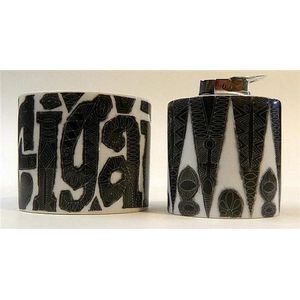Wilkinson Oriflamme Ginger Jar, Circa 1900
You must be a subscriber, and be logged in to view price and dealer details.
Subscribe Now to view actual auction price for this item
When you subscribe, you have the option of setting the currency in which to display prices to $Au, $US, $NZ or Stg.
- Oviform /ovoid - The outline loosely resembling the shape of an egg.
- Circa - A Latin term meaning 'about', often used in the antique trade to give an approximate date for the piece, usually considered to be five years on either side of the circa year. Thus, circa 1900 means the piece was made about 1900, probably between 1895 and 1905. The expression is sometimes abbreviated to c.1900.
- Lustre Ware - Lustre decoration on ceramics is created by painting a thin deposit of metal oxide such as gold, silver or copper onto the surface, and then firing the item again, so that metal oxide forms a thin film on the surface. The finished effect is a shiny metallic surface. The technique was used in the 19th century by potteries such as Crown Devon, Grimwades, Maling, and Royal Doulton. However the best known use was by Wedgwood for its Fairyland lustre.
This item has been included into following indexes:
Visually similar items

Pair of bi-colour gold and diamond earrings, Tiffany & Co. Each sculpted elliptical half hoop bordered by a line of brilliant-cut diamonds, approximately 15 x 10 mm, signed Tiffany & Co., post and clip fittings.

A handbag by Chanel, styled in cream quilted canvas with Chanel print and logo detail in black, red and blue, with conforming gold metal chain shoulder strap, authenticity card included 10573470, 23 x 17 x 8 cm, with box

Royal crown Derby 'Starlight Hair' paperweight with gold button seal and signature to base, height 13.5 cm

A Rosenthal Studio line cigarette lighter signed Bjorn Weinblad and a signed cigarette holder
